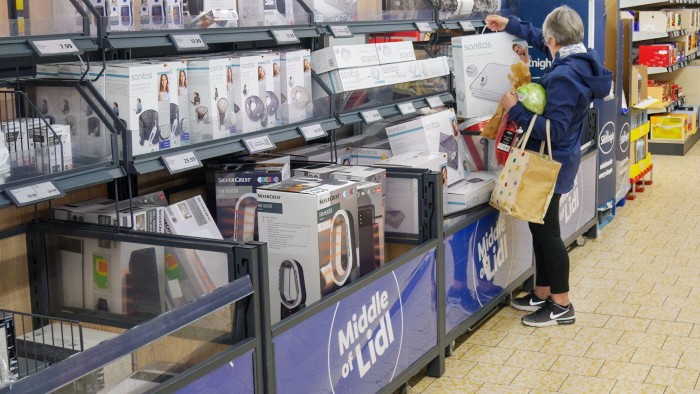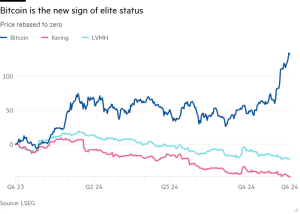The lure of Lidl’s middle is no riddle

Stay informed with free updates
Simply sign up to the Retail sector myFT Digest — delivered directly to your inbox.
It wasn’t so much the weight of the thing, but its bulk. It wouldn’t fit under my arm, so I needed both hands to carry it home, with everything else I’d bought shoved into my jacket pockets.
Of course I’d gone to Lidl for some parsnips and a block of butter, not a 100-litre water butt. But I couldn’t help myself — it was £12 cheaper than the same item at a leading DIY chain and we did — sort of — need one.
I am not alone. Men are more likely than women to buy from the famed middle aisle of random stuff, the retailer’s UK boss Ryan McDonnell told the BBC this week. “We often get partners at odds with each other because men have disappeared up the aisle and are buying things they maybe already have,” he said.
That may be because drills, angle grinders, socket sets and other man-cave staples loom large in the middle-aisle mix. Leisure items such as wetsuits and stand-up paddle-boards are another major category at certain times of the year.
A study by three University of Sussex academics found that men “tend to impulsively buy instrumental and leisure items projecting independence and activity.” Women, on the other hand, buy more “symbolic and self-expressive goods concerned with appearance and emotional aspects of self” — less frequent finds in the middle aisle bazaar.
When Germany-based Lidl and compatriot Aldi arrived in Britain in the 1990s, the middle aisle’s main appeal was cheapness. But mirroring the discounters’ wider march upmarket, it has now become the middle-class aisle — Dyson-style bladeless cooling fans are one aspirational addition this year.
Homegrown supermarkets such as Tesco and Asda tend to concentrate on a relatively fixed range of homewares, electrical items and clothing, meaning that permanent store space is given over to things people purchase only occasionally. “Lidl is a different proposition, it’s solving many more shopping missions and giving customers reasons to come to you,” said Ronny Gottschlich, who ran the group’s UK operation from 2010 to 2016.
The middle aisle’s fans are vocal. There are Facebook pages, Reddit threads and even a song by a group of Welsh rappers documenting bizarre impulse purchases, from trumpets and trombones to canoes and chainsaws.
At the retailer’s UK head office in Tolworth, a team of over 50 buyers keeps the surprises coming. Some products are tailored to the UK but there is extensive crossover with ranges elsewhere; Lidl’s Parkside brand of power tools, promoted by Arnold Schwarzenegger, is Europe’s biggest-selling DIY brand.
Low prices and the notion of strictly limited stock help drive the buying impulse. It’s a model widely used elsewhere; department store TK Maxx markets itself as a “treasure hunt” where stock is updated often and sold quickly. Chains like B&M in the UK and Action across Europe also have core ranges in key sectors augmented by an ever-changing seasonal offering.
Lidl doesn’t reveal what portion of its £10.9bn in UK revenue is generated from middle-aisle sales, though Gottschlich said it is unlikely to be more than around 15 per cent — but at margins that could be up to 10 percentage points higher than those in the bitterly competitive grocery market.
Because every store is laid out the same way, it’s easy to stay out of trouble by following the “racetrack” — the two aisles nearest the perimeter, which contain most of life’s essentials. Though be warned: that journey usually concludes in the wine section.
The tactic of persuading shoppers that they need to buy seemingly random items has, of course, been around for as long as any shop. Decades ago, my father-in-law was dispatched to buy a bag of potatoes from a corner shop. He returned a good deal later having bought a car — but forgotten the spuds.
The writer is a former retail correspondent
#lure #Lidls #middle #riddle




